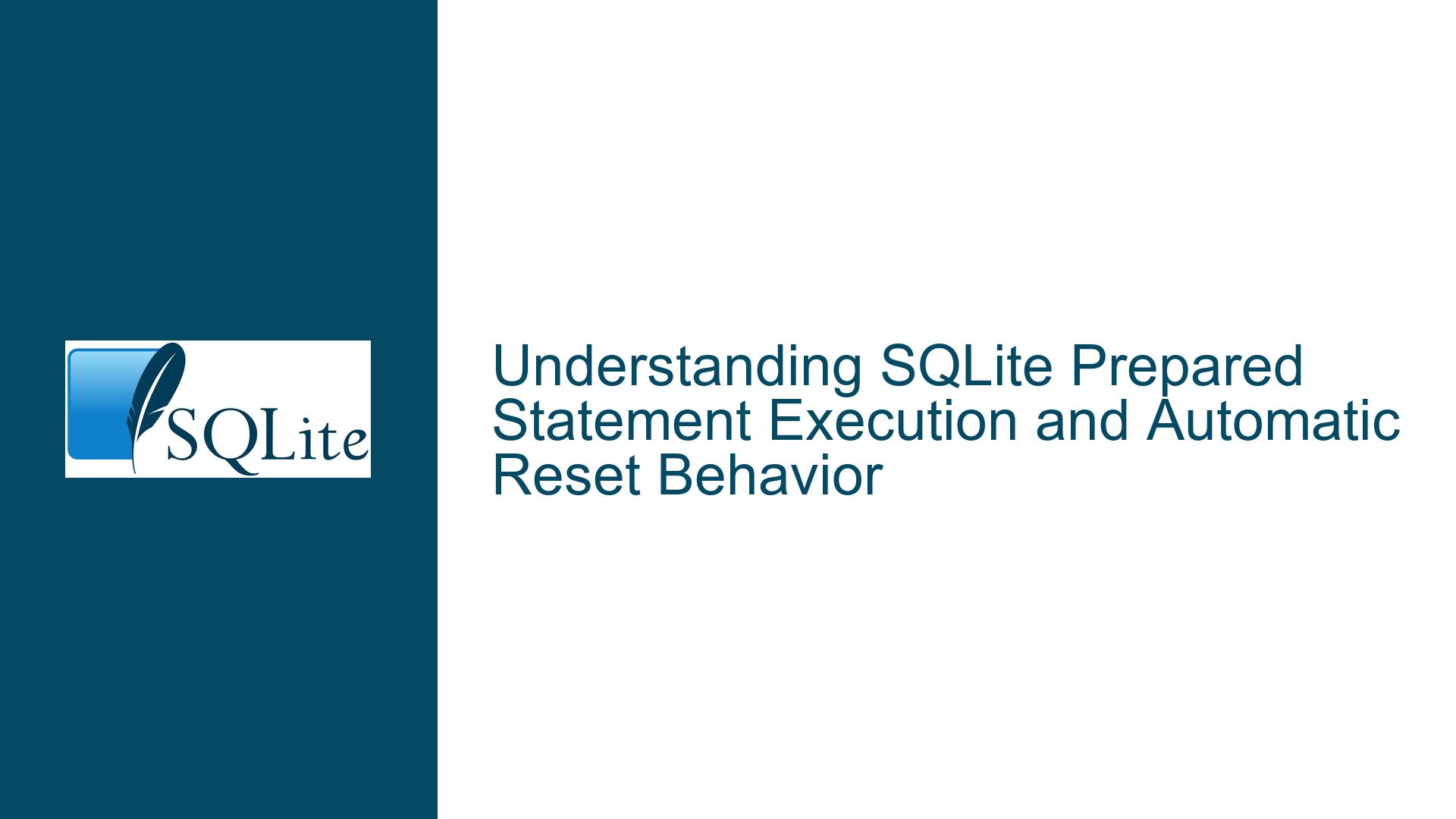SQLite Prepared Statement Execution and Automatic Reset Behavior
SQLite Prepared Statements: Automatic Reset and Execution States
SQLite prepared statements are a powerful feature for optimizing database operations, particularly when executing repetitive queries or inserts. However, their behavior, especially regarding execution states and automatic reset functionality, can be nuanced and sometimes misunderstood. This post delves into the intricacies of SQLite prepared statements, focusing on how they handle execution, reset, and state transitions, particularly in the context of repeated executions without explicit resets.
Execution States of SQLite Prepared Statements
A SQLite prepared statement can be in one of three primary states: "Never Executed," "Executing and Produced Result," and "Done Execution." Understanding these states is crucial for effectively managing prepared statements.
Never Executed: This is the initial state of a prepared statement after it has been created using
sqlite3_prepare_v2or a similar function. In this state, the statement is ready to be executed but has not yet been run.Executing and Produced Result: When
sqlite3_stepis called on a prepared statement, it transitions to this state. ForSELECTstatements, this state indicates that a row of data is available for processing. The statement remains in this state untilsqlite3_stepis called again, which either fetches the next row or transitions the statement to the "Done Execution" state.Done Execution: This state is reached when a prepared statement has completed its execution. For
INSERT,UPDATE, orDELETEstatements, this typically means that the operation has been successfully executed. ForSELECTstatements, it indicates that all rows have been fetched.
Automatic Reset Mechanism in SQLite
Starting with SQLite version 3.7.0, an automatic reset mechanism was introduced to simplify the management of prepared statements. This mechanism automatically resets a prepared statement to the "Never Executed" state after it reaches the "Done Execution" state. This means that, in most cases, you do not need to explicitly call sqlite3_reset before re-executing a prepared statement.
The automatic reset occurs under the following conditions:
- After a
sqlite3_stepcall returnsSQLITE_DONE. - After a
sqlite3_stepcall returns an error code (e.g.,SQLITE_ERROR).
This behavior is particularly useful for INSERT statements, which typically do not produce multiple rows of results. When you call sqlite3_step on an INSERT statement, it executes the operation and immediately returns SQLITE_DONE, triggering the automatic reset. This allows you to re-execute the same prepared statement without manually resetting it.
Differences Between INSERT and SELECT Statements
While the automatic reset mechanism works seamlessly for INSERT statements, the behavior can be different for SELECT statements, especially those that return multiple rows. Understanding these differences is key to avoiding common pitfalls.
INSERT Statements: As mentioned earlier,
INSERTstatements typically returnSQLITE_DONEimmediately after execution. This triggers the automatic reset, allowing the statement to be re-executed without manual intervention.SELECT Statements: For
SELECTstatements, the behavior is more complex. The first call tosqlite3_steppositions the cursor on the first row of the result set and returnsSQLITE_ROW. Subsequent calls tosqlite3_stepfetch additional rows until no more rows are available, at which pointSQLITE_DONEis returned. Only afterSQLITE_DONEis returned does the automatic reset occur.
This difference in behavior can lead to confusion, particularly when dealing with single-row result sets. If you attempt to fetch data from a SELECT statement after it has returned SQLITE_DONE but before it has been reset, the column data will be NULL. This is because the cursor is no longer positioned on a valid row.
Practical Implications and Best Practices
Understanding the execution states and automatic reset mechanism of SQLite prepared statements has several practical implications:
Reusing Prepared Statements: When reusing prepared statements, especially in loops, it is essential to understand whether an automatic reset will occur. For
INSERTstatements, you can typically rely on the automatic reset. ForSELECTstatements, you may need to manually reset the statement if you intend to re-execute it before it reaches the "Done Execution" state.Error Handling: Proper error handling is crucial when working with prepared statements. If an error occurs during execution, the statement will transition to the "Done Execution" state, and an automatic reset will occur. However, you should still check the return codes of
sqlite3_stepand handle errors appropriately.Binding Parameters: When reusing prepared statements, be mindful of parameter bindings. The automatic reset does not clear any bound parameters. If you need to change the parameters for the next execution, you must rebind them. Alternatively, you can use
sqlite3_clear_bindingsto clear all bindings before reusing the statement.Performance Considerations: While the automatic reset mechanism simplifies the management of prepared statements, it is still important to consider performance implications. For example, repeatedly preparing and finalizing statements can be more expensive than reusing a prepared statement with proper reset and binding management.
Troubleshooting Common Issues
When working with SQLite prepared statements, several common issues can arise, particularly related to execution states and automatic reset behavior. Here are some troubleshooting steps and solutions:
Issue: SELECT Statement Returns NULL After First Execution
- Cause: This issue typically occurs when a
SELECTstatement is executed multiple times without a manual reset. After the first execution, the statement reaches the "Done Execution" state, and subsequent calls tosqlite3_stepreturnSQLITE_DONEwithout positioning the cursor on a valid row. - Solution: Ensure that you manually reset the
SELECTstatement usingsqlite3_resetbefore re-executing it. This will return the statement to the "Never Executed" state, allowing it to fetch data again.
- Cause: This issue typically occurs when a
Issue: INSERT Statement Fails on Second Execution
- Cause: This issue can occur if the prepared statement is not properly reset or if the bound parameters are not updated before re-execution.
- Solution: Verify that the automatic reset is occurring as expected. If necessary, manually reset the statement using
sqlite3_reset. Additionally, ensure that any bound parameters are updated or cleared before re-executing the statement.
Issue: Memory Leaks or Resource Exhaustion
- Cause: Memory leaks or resource exhaustion can occur if prepared statements are not properly finalized. While the automatic reset mechanism helps manage execution states, it does not free the resources associated with the prepared statement.
- Solution: Always finalize prepared statements using
sqlite3_finalizewhen they are no longer needed. This will free the associated memory and resources.
Issue: Unexpected Behavior with Complex Queries
- Cause: Complex queries, particularly those involving joins or subqueries, can exhibit unexpected behavior if the execution states are not properly managed.
- Solution: Carefully manage the execution states of prepared statements, especially when dealing with complex queries. Use manual resets as needed and ensure that the statement is in the correct state before re-executing it.
Conclusion
SQLite prepared statements are a powerful tool for optimizing database operations, but their behavior can be nuanced, particularly regarding execution states and automatic reset functionality. By understanding these nuances and following best practices, you can effectively manage prepared statements and avoid common pitfalls. Whether you’re working with simple INSERT statements or complex SELECT queries, a thorough understanding of SQLite’s execution and reset mechanisms will help you write more efficient and reliable code.






